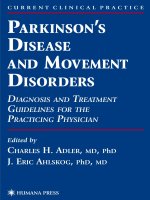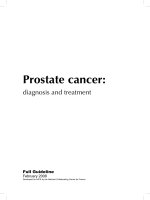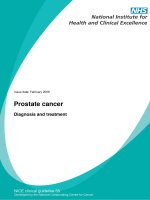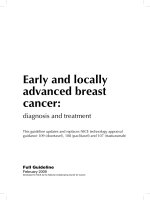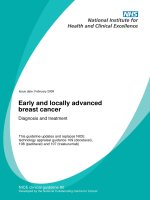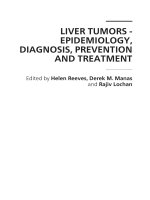Prostate cancer - Diagnosis and treatment pot
Bạn đang xem bản rút gọn của tài liệu. Xem và tải ngay bản đầy đủ của tài liệu tại đây (512.73 KB, 41 trang )
Issue date: February 2008
NICE clinical guideline 58
Developed by the National Collaborating Centre for Cancer
Prostate cance
r
Diagnosis and treatment
NICE clinical guideline 58
Prostate cancer: diagnosis and treatment
Ordering information
You can download the following documents from www.nice.org.uk/CG058
• The NICE guideline (this document) – all the recommendations.
• A quick reference guide – a summary of the recommendations for
healthcare professionals.
• ‘Understanding NICE guidance’ – information for patients and carers.
• The full guideline – all the recommendations, details of how they were
developed, and reviews of the evidence they were based on.
For printed copies of the quick reference guide or ‘Understanding NICE
guidance’, phone NICE publications on 0845 003 7783 or email
and quote:
• N1457 (quick reference guide)
• N1458 (‘Understanding NICE guidance’).
NICE clinical guidelines are recommendations about the treatment and care of
people with specific diseases and conditions in the NHS in England and
Wales
This guidance represents the view of the Institute, which was arrived at after
careful consideration of the evidence available. Healthcare professionals are
expected to take it fully into account when exercising their clinical judgement.
The guidance does not, however, override the individual responsibility of
healthcare professionals to make decisions appropriate to the circumstances
of the individual patient, in consultation with the patient and/or guardian or
carer and informed by the summary of product characteristics of any drugs
they are considering.
National Institute for Health and Clinical Excellence
MidCity Place
71 High Holborn
London
WC1V 6NA
www.nice.org.uk
© National Institute for Health and Clinical Excellence, 2008. All rights reserved. This material
may be freely reproduced for educational and not-for-profit purposes. No reproduction by or
for commercial organisations, or for commercial purposes, is allowed without the express
written permission of the Institute.
Contents
Introduction 1
Patient-centred care 2
Key priorities for implementation 3
1 Guidance 5
1.1 Communication and support 5
1.2 Diagnosis and staging of prostate cancer 6
1.3 Localised prostate cancer 10
1.4 Managing adverse effects of treatment 13
1.5 Managing relapse after radical treatment 15
1.6 Locally advanced prostate cancer 16
1.7 Metastatic prostate cancer 17
2 Notes on the scope of the guidance 22
3 Implementation 23
4 Research recommendations 24
4.1 Prognostic factors 24
4.2 Treatments aimed at elimination of disease 24
5 Other versions of this guideline 25
5.1 Full guideline 25
5.2 Quick reference guide 25
5.3 ‘Understanding NICE guidance’ 25
6 Related NICE guidance 25
7 Updating the guideline 27
Appendix A: The Guideline Development Group 28
Appendix B: The Guideline Review Panel 30
Appendix C: The algorithms 31
Appendix D: Definitions used in this guideline 38
Introduction
Prostate cancer is one of the most common cancers in men. Every year there
are 34,986 new cases in England and Wales and 10,000 deaths
1
. Prostate
cancer is predominantly a disease of older men but around 20% of cases
occur in men under the age of 65 years. Over the past 10 to 15 years there
have been a number of significant advances in prostate cancer management
but also a number of major controversies, especially about the clinical
management of men with early, non-metastatic disease. These uncertainties
clearly cause anxieties for men with prostate cancer and their families. There
is evidence of practice variation around the country and of patchy availability
of certain treatments and procedures. A clinical guideline will help to address
these issues and offer guidance on best practice.
The guideline assumes that prescribers will use a drug’s summary of product
characteristics to inform their decisions for individual patients.
Definitions used in this guideline are provided in appendix D on page 38 and
can be viewed individually by clicking on hyperlinked words in the text.
.
1
Cancer Research UK (2007). Available from www.cancerresearchuk.org
NICE clinical guideline 58 – Prostate cancer 1
Patient-centred care
This guideline offers best practice advice on the care of men with prostate
cancer.
Treatment and care should take into account the man's needs and
preferences. Men with prostate cancer should have the opportunity to make
informed decisions about their care and treatment, in partnership with their
healthcare professionals. If men with prostate cancer do not have the capacity
to make decisions, healthcare professionals should follow the Department of
Health guidelines – ‘Reference guide to consent for examination or treatment’
(2001; available from www.dh.gov.uk). Healthcare professionals should also
follow a code of practice accompanying the Mental Capacity Act (summary
available from www.publicguardian.gov.uk).
Good communication between healthcare professionals and men with
prostate cancer is essential. It should be supported by evidence-based written
information tailored to the man's needs. Treatment and care, and the
information men with prostate cancer are given about it, should be culturally
appropriate. It should also be accessible to people with additional needs such
as physical, sensory or learning disabilities, and to people who do not speak
or read English.
If the man agrees, his partner, family and carers should have the opportunity
to be involved in decisions about treatment and care. Families and carers
should also be given the information and support they need.
NICE clinical guideline 58 – Prostate cancer 2
Key priorities for implementation
• Healthcare professionals should adequately inform men with prostate
cancer and their partners or carers about the effects of prostate cancer and
the treatment options on their sexual function, physical appearance,
continence and other aspects of masculinity. Healthcare professionals
should support men and their partners or carers in making treatment
decisions, taking into account the effects on quality of life as well as
survival.
• To help men decide whether to have a prostate biopsy, healthcare
professionals should discuss with them their prostate specific antigen
(PSA) level, digital rectal examination (DRE) findings (including an estimate
of prostate size) and comorbidities, together with their risk factors (including
increasing age and black African or black Caribbean ethnicity) and any
history of a previous negative prostate biopsy. The serum PSA level alone
should not automatically lead to a prostate biopsy.
• Men with low-risk localised prostate cancer who are considered suitable for
radical treatment should first be offered active surveillance.
• Men undergoing radical external beam radiotherapy for localised prostate
cancer
2
should receive a minimum dose of 74 Gy to the prostate at no
more than 2 Gy per fraction.
• Healthcare professionals should ensure that men and their partners have
early and ongoing access to specialist erectile dysfunction services.
• Healthcare professionals should ensure that men with troublesome urinary
symptoms after treatment have access to specialist continence services for
assessment, diagnosis and conservative treatment. This may include
coping strategies, along with pelvic floor muscle re-education, bladder
retraining and pharmacotherapy.
• Healthcare professionals should refer men with intractable stress
incontinence to a specialist surgeon for consideration of an artificial urinary
sphincter.
2
This may also apply to some men with locally advanced prostate cancer.
NICE clinical guideline 58 – Prostate cancer 3
• Biochemical relapse (a rising PSA) alone should not necessarily prompt an
immediate change in treatment.
• Hormonal therapy is not routinely recommended for men with prostate
cancer who have a biochemical relapse unless they have:
• symptomatic local disease progression, or
• any proven metastases, or
• a PSA doubling time < 3 months.
• When men with prostate cancer develop biochemical evidence of hormone-
refractory disease, their treatment options should be discussed by the
urological cancer multidisciplinary team (MDT) with a view to seeking an
oncologist and/or specialist palliative care opinion, as appropriate.
• Healthcare professionals should ensure that palliative care is available
when needed and is not limited to the end of life. It should not be restricted
to being associated with hospice care.
NICE clinical guideline 58 – Prostate cancer 4
1 Guidance
The following guidance is based on the best available evidence. The full
guideline www.nice.org.uk/CG058fullguideline gives details of the methods
and the evidence used to develop the guidance.
1.1 Communication and support
1.1.1 The recommendations on communication and patient-centred care
made in the two NICE cancer service guidance documents
‘Improving outcomes in urological cancers’ (2002) and ‘Improving
supportive and palliative care for adults with cancer’ (2004) should
be followed throughout the patient journey.
1.1.2 Men with prostate cancer should be offered individualised
information tailored to their own needs. This information should be
given by a healthcare professional (for example, a consultant or
specialist nurse) and may be supported by written and visual media
(for example, slide sets or DVDs).
1.1.3 Men with prostate cancer should be offered advice on how to
access information and support from websites (for example, UK
Prostate Link – www.prostate-link.org.uk), local and national cancer
information services, and from cancer support groups.
1.1.4 Before choosing or recommending information resources for men
with prostate cancer, healthcare professionals should check that
their content is clear, reliable and up-to-date.
1.1.5 Healthcare professionals should seek feedback from men with
prostate cancer and their carers to identify the highest quality
information resources.
1.1.6 Healthcare professionals caring for men with prostate cancer
should ascertain the extent to which the man wishes to be involved
NICE clinical guideline 58 – Prostate cancer 5
in decision making and ensure that he has sufficient information to
do so.
1.1.7 A validated, up-to-date decision aid is recommended for use in all
urological cancer multidisciplinary teams (MDTs). It should be
offered to men with localised prostate cancer when making
treatment decisions, by healthcare professionals trained in its use
3
.
1.1.8 Healthcare professionals should discuss all relevant management
options recommended in this guideline with men with prostate
cancer and their partners or carers, irrespective of whether they are
available through local services.
1.1.9 Healthcare professionals should ensure that mechanisms are in
place to allow men with prostate cancer and their primary care
providers to gain access to specialist services throughout the
course of their disease.
1.1.10 Healthcare professionals should adequately inform men with
prostate cancer and their partners or carers about the effects of
prostate cancer and the treatment options on their sexual function,
physical appearance, continence and other aspects of masculinity.
Healthcare professionals should support men and their partners or
carers in making treatment decisions, taking into account the
effects on quality of life as well as survival.
1.1.11 Healthcare professionals should offer men with prostate cancer and
their partners or carers the opportunity to talk to a healthcare
professional experienced in dealing with psychosexual issues at
any stage of the illness and its treatment.
1.2 Diagnosis and staging of prostate cancer
Men who are diagnosed with prostate cancer usually present in primary care
with no clear symptoms of the disease. This section assumes that men have
3
A decision aid for men with localised prostate cancer is in development in the UK by the
Urology Informed Decision Making Steering Group (publication expected 2008).
NICE clinical guideline 58 – Prostate cancer 6
had a digital rectal examination (DRE) and usually a prostate specific antigen
(PSA) test in the primary care setting, as set out in ‘Referral guidelines for
suspected cancer’ (NICE clinical guideline 27).
Biopsy
The aim of prostate biopsy is to detect prostate cancers with the potential for
causing harm rather than detecting each and every cancer. Men with clinically
insignificant prostate cancers that are unlikely to cause symptoms or affect life
expectancy may not benefit from knowing that they have the disease. Indeed,
the detection of clinically insignificant prostate cancer should be regarded as
an under-recognised adverse effect of biopsy.
1.2.1 To help men decide whether to have a prostate biopsy, healthcare
professionals should discuss with them their PSA level, DRE
findings (including an estimate of prostate size) and comorbidities,
together with their risk factors (including increasing age and black
African or black Caribbean ethnicity) and any history of a previous
negative prostate biopsy. The serum PSA level alone should not
automatically lead to a prostate biopsy.
1.2.2 Men and their partners or carers should be given information,
support and adequate time to decide whether or not they wish to
undergo prostate biopsy. The information should include an
explanation of the risks (including the increased chance of having
to live with the diagnosis of clinically insignificant prostate cancer)
and benefits of prostate biopsy.
1.2.3 If the clinical suspicion of prostate cancer is high, because of a high
PSA value and evidence of bone metastases (identified by a
positive isotope bone scan or sclerotic metastases on plain
radiographs), prostate biopsy for histological confirmation should
not be performed, unless this is required as part of a clinical trial.
NICE clinical guideline 58 – Prostate cancer 7
1.2.4 Healthcare professionals should carry out prostate biopsy following
the procedure recommended in ‘Undertaking a transrectal
ultrasound guided biopsy of the prostate’ (PCRMP 2006)
4
.
1.2.5 The results of all prostate biopsies should be reviewed by a
urological cancer MDT. Men should only be re-biopsied following a
negative biopsy after an MDT review of the risk characteristics
including life expectancy, PSA, DRE and prostate volume.
1.2.6 Men should decide whether or not to have a re-biopsy following a
negative biopsy, having had the risks and benefits explained to
them.
Imaging
The clinical presentation and the treatment intent influence the decision about
when and how to image an individual. Men with localised prostate cancer are
stratified into risk groups according to their risk of recurrence (see table 1).
Table 1 Risk stratification for men with localised prostate cancer.
PSA Gleason
score
Clinical
stage
Low risk
< 10 ng/ml
and
≤ 6
and
T1-T2a
Intermediate risk
10–20 ng/ml
or
7
or
T2b-T2c
High risk
> 20 ng/ml
or
8-10
or
T3-T4
5
1.2.7 Healthcare professionals should determine the provisional
treatment intent (radical or non-radical) before decisions on
imaging are made.
1.2.8 Imaging is not routinely recommended for men in whom no radical
treatment is intended.
4
‘Undertaking a transrectal ultrasound guided biopsy of the prostate’ (Prostate Cancer Risk
Management Programme 2006). Available from:
www.cancerscreening.nhs.uk/prostate/pcrmp01.pdf
5
Clinical stage T3-T4 represents locally advanced disease.
NICE clinical guideline 58 – Prostate cancer 8
1.2.9 Computerised tomography (CT) of the pelvis is not recommended
for men with low- or intermediate-risk localised prostate cancer
(see table 1).
1.2.10 Men with high-risk localised (see table 1) and locally advanced
prostate cancer who are being considered for radical treatment
should have pelvic imaging with either magnetic resonance imaging
(MRI), or CT if MRI is contraindicated.
1.2.11 Magnetic resonance spectroscopy is not recommended for men
with prostate cancer except in the context of a clinical trial.
1.2.12 Isotope bone scans are not routinely recommended for men with
low-risk localised prostate cancer.
1.2.13 Isotope bone scans should be performed when hormonal therapy is
being deferred through watchful waiting in asymptomatic men who
are at high risk of developing bone complications.
1.2.14 Positron emission tomography imaging for prostate cancer is not
recommended in routine clinical practice.
Nomograms
1.2.15 Nomograms may be used by healthcare professionals in
partnership with men with prostate cancer to:
• aid decision making
• help predict biopsy results
• help predict pathological stage
• help predict risk of treatment failure.
1.2.16 When nomograms are used, healthcare professionals should
clearly explain the reliability, validity and limitations of the
prediction.
NICE clinical guideline 58 – Prostate cancer 9
1.3 Localised prostate cancer
Men with high-risk localised prostate cancer (see table 1) may be managed as
set out in section 1.6 (locally advanced prostate cancer).
Watchful waiting and active surveillance
1.3.1 Urological cancer MDTs should assign a risk category (see table 1)
to all newly diagnosed men with localised prostate cancer.
1.3.2 Men with localised prostate cancer who have chosen a watchful
waiting regimen and who have evidence of significant disease
progression (that is, rapidly rising PSA level or bone pain) should
be reviewed by a member of the urological cancer MDT.
1.3.3 Men with low-risk localised prostate cancer (see table 1) who are
considered suitable for radical treatment should first be offered
active surveillance.
1.3.4 Active surveillance is particularly suitable for a subgroup of men
with low-risk localised prostate cancer who have clinical stage T1c,
a Gleason score of 3+3, a PSA density of < 0.15 ng/ml/ml and who
have cancer in less than 50% of their total number of biopsy cores
with < 10 mm of any core involved.
1.3.5 Active surveillance should be discussed as an option with men who
have intermediate-risk localised prostate cancer (see table 1).
1.3.6 Active surveillance is not recommended for men with high-risk
localised prostate cancer.
1.3.7 To reduce the sampling error associated with prostate biopsy, men
who are candidates for active surveillance should have at least
10 biopsy cores taken.
NICE clinical guideline 58 – Prostate cancer 10
1.3.8 Active surveillance should include at least one re-biopsy and may
be performed in accordance with the ProSTART
6
protocol.
1.3.9 Men with localised prostate cancer who have chosen an active
surveillance regimen and who have evidence of disease
progression (that is, a rise in PSA level or adverse findings on
biopsy) should be offered radical treatment.
1.3.10 The decision to proceed from an active surveillance regimen to
radical treatment should be made in the light of the individual man’s
personal preferences, comorbidities and life expectancy.
Radical treatment
1.3.11 Healthcare professionals should offer radical prostatectomy or
radical radiotherapy (conformal) to men with intermediate-risk
localised prostate cancer.
1.3.12 Healthcare professionals should offer radical prostatectomy or
radical radiotherapy (conformal) to men with high-risk localised
prostate cancer when there is a realistic prospect of long-term
disease control.
1.3.13 Brachytherapy is not recommended for men with high-risk localised
prostate cancer.
1.3.14 Clinical oncologists should use conformal radiotherapy for men with
localised prostate cancer
7
receiving radical external beam
radiotherapy.
1.3.15 Men undergoing radical external beam radiotherapy for localised
prostate cancer
7
should receive a minimum dose of 74 Gy to the
prostate at no more than 2 Gy per fraction.
6
Phase III randomized study of active surveillance versus radical treatment in patients with
favorable-risk prostate cancer. (www.cancer.gov/clinicaltrials/CAN-NCIC-CTG-PR11
)
7
This may also apply to some men with locally advanced prostate cancer.
NICE clinical guideline 58 – Prostate cancer 11
1.3.16 Adjuvant hormonal therapy is recommended for a minimum of
2 years in men receiving radical radiotherapy for localised prostate
cancer who have a Gleason score of ≥ 8.
1.3.17 High-intensity focused ultrasound and cryotherapy are not
recommended for men with localised prostate cancer other than in
the context of controlled clinical trials comparing their use with
established interventions
8
.
Follow-up
1.3.18 Healthcare professionals should discuss the purpose, duration,
frequency and location of follow-up with each man with localised
prostate cancer
9
, and if he wishes, his partner or carers.
1.3.19 Men with prostate cancer should be clearly advised about potential
longer term adverse effects of treatment and when and how to
report them.
1.3.20 Men with prostate cancer who have chosen a watchful waiting
regimen with no curative intent should normally be followed up in
primary care in accordance with protocols agreed by the local
urological cancer MDT and the relevant primary care
organisation(s). Their PSA should be measured at least once a
year.
1.3.21 PSA levels for all men with prostate cancer who are having radical
treatment should be checked at the earliest 6 weeks following
treatment, at least every 6 months for the first 2 years and then at
least once a year thereafter.
1.3.22 Routine DRE is not recommended in men with localised prostate
cancer while the PSA remains at baseline levels.
8
NICE interventional procedures guidance 118,119 and 145 evaluated the safety and efficacy
of cryotherapy and high-intensity focused ultrasound for the treatment of prostate cancer.
NICE clinical guidelines provide guidance on the appropriate treatment and care of people
with specific diseases and conditions within the NHS. As there was a lack of evidence on
quality of life benefits and long-term survival these interventions are not recommended in this
guideline.
9
This may also apply to some men with locally advanced prostate cancer.
NICE clinical guideline 58 – Prostate cancer 12
1.3.23 After at least 2 years, men with a stable PSA who have had no
significant treatment complications, should be offered follow-up
outside hospital (for example, in primary care) by telephone or
secure electronic communications, unless they are taking part in a
clinical trial that requires formal clinic-based follow-up. Direct
access to the urological cancer MDT should be offered and
explained.
1.4 Managing adverse effects of treatment
1.4.1 Given the range of treatment modalities and their serious side
effects, men with prostate cancer who are candidates for radical
treatment should have the opportunity to discuss their treatment
options with a specialist surgical oncologist and a specialist clinical
oncologist.
1.4.2 Men presenting with symptoms consistent with radiation-induced
enteropathy should be fully investigated (including using flexible
sigmoidoscopy) to exclude inflammatory bowel disease or
malignancy of the large bowel and to ascertain the nature of the
radiation injury. Particular caution should be taken with anterior wall
rectal biopsy following brachytherapy because of the risk of
fistulation.
1.4.3 Men treated with radical radiotherapy for prostate cancer should be
offered flexible sigmoidoscopy every 5 years.
1.4.4 Steroid enemas should not be used for treating men with radiation
proctopathy.
1.4.5 The nature and treatment of radiation-induced injury to the
gastrointestinal tract should be included in the training programmes
for oncologists and gastroenterologists.
1.4.6 Prior to treatment, men and their partners should be warned that
treatment for prostate cancer will result in an alteration of sexual
experience, and may result in loss of sexual function.
NICE clinical guideline 58 – Prostate cancer 13
1.4.7 Men and their partners should be warned about the potential loss of
ejaculation and fertility associated with treatment for prostate
cancer. Sperm storage should be offered.
1.4.8 Healthcare professionals should ensure that men and their partners
have early and ongoing access to specialist erectile dysfunction
services.
1.4.9 Men with prostate cancer who experience loss of erectile function
should be offered phosphodiesterase type 5 (PDE5) inhibitors to
improve their chance of spontaneous erections.
1.4.10 If PDE5 inhibitors fail to restore erectile function or are
contraindicated, men should be offered vacuum devices,
intraurethral inserts or penile injections, or penile prostheses as an
alternative.
1.4.11 Men experiencing troublesome urinary symptoms before treatment
should be offered a urological assessment.
1.4.12 Men undergoing treatment for prostate cancer should be warned of
the likely effects of the treatment on their urinary function.
1.4.13 Healthcare professionals should ensure that men with troublesome
urinary symptoms after treatment have access to specialist
continence services for assessment, diagnosis and conservative
treatment. This may include coping strategies, along with pelvic
floor muscle re-education, bladder retraining and pharmacotherapy.
1.4.14 Healthcare professionals should refer men with intractable stress
incontinence to a specialist surgeon for consideration of an artificial
urinary sphincter.
1.4.15 The injection of bulking agents into the distal urinary sphincter is
not recommended to treat stress incontinence.
NICE clinical guideline 58 – Prostate cancer 14
1.5 Managing relapse after radical treatment
1.5.1 Analyse serial PSA levels after radical treatment using the same
assay technique.
1.5.2 Biopsy of the prostatic bed should not be performed in men with
prostate cancer who have had a radical prostatectomy.
1.5.3 Biopsy of the prostate after radiotherapy should only be performed
in men with prostate cancer who are being considered for local
salvage therapy in the context of a clinical trial.
1.5.4 For men with evidence of biochemical relapse following radical
treatment and who are considering radical salvage therapy:
• routine MRI scanning should not be performed prior to salvage
radiotherapy in men with prostate cancer
• an isotope bone scan should be performed if symptoms or PSA
trends are suggestive of metastases.
1.5.5 Biochemical relapse (a rising PSA) alone should not necessarily
prompt an immediate change in treatment.
1.5.6 Biochemical relapse should trigger an estimate of PSA doubling
time, based on a minimum of 3 measurements over at least a
6 month period.
1.5.7 Men with biochemical relapse after radical prostatectomy, with no
known metastases, should be offered radical radiotherapy to the
prostatic bed.
1.5.8 Men with biochemical relapse should be considered for entry to
appropriate clinical trials
10
.
1.5.9 Hormonal therapy is not routinely recommended for men with
prostate cancer who have a biochemical relapse unless they have:
10
For example, RADICALS (Radiotherapy and androgen deprivation in combination after
local surgery; www.ctu.mrc.ac.uk/studies/PR10.asp
)
NICE clinical guideline 58 – Prostate cancer 15
• symptomatic local disease progression, or
• any proven metastases, or
• a PSA doubling time of < 3 months.
1.6 Locally advanced prostate cancer
There is no universally accepted definition of locally advanced prostate
cancer. It covers a spectrum of disease from a tumour that has spread
through the capsule of the prostate (T3a) to large T4 cancers that may be
invading the bladder or rectum or have spread to pelvic lymph nodes.
Systemic treatment
1.6.1 Neoadjuvant and concurrent luteinising hormone-releasing
hormone agonist (LHRHa) therapy is recommended for 3 to
6 months in men receiving radical radiotherapy for locally advanced
prostate cancer.
1.6.2 Adjuvant hormonal therapy in addition to radical prostatectomy is
not recommended, even in men with margin-positive disease, other
than in the context of a clinical trial.
1.6.3 Adjuvant hormonal therapy is recommended for a minimum of
2 years in men receiving radical radiotherapy for locally advanced
prostate cancer who have a Gleason score of ≥ 8.
1.6.4 Bisphosphonates should not be used for the prevention of bone
metastases in men with prostate cancer.
Radiotherapy
1.6.5 Clinical oncologists should consider pelvic radiotherapy in men with
locally advanced prostate cancer who have a > 15% risk of pelvic
lymph node involvement
11
and who are to receive neoadjuvant
hormonal therapy and radical radiotherapy.
11
Estimated using the Roach formula: %LN risk = 2/3 PSA + (10 x [Gleason score - 6])
NICE clinical guideline 58 – Prostate cancer 16
1.6.6 Immediate post-operative radiotherapy after radical prostatectomy
is not routinely recommended, even in men with margin-positive
disease, other than in the context of a clinical trial
12
.
1.6.7 High-intensity focused ultrasound and cryotherapy are not
recommended for men with locally advanced prostate cancer other
than in the context of controlled clinical trials comparing their use
with established interventions
13
.
1.7 Metastatic prostate cancer
Hormonal therapy
1.7.1 Healthcare professionals should offer bilateral orchidectomy to all
men with metastatic prostate cancer as an alternative to continuous
LHRHa therapy.
1.7.2 Combined androgen blockade is not recommended as a first-line
treatment for men with metastatic prostate cancer.
1.7.3 For men with metastatic prostate cancer who are willing to accept
the adverse impact on overall survival and gynaecomastia in the
hope of retaining sexual function, anti-androgen monotherapy with
bicalutamide (150 mg)
14
should be offered.
1.7.4 Healthcare professionals should begin androgen withdrawal
and
stop bicalutamide treatment in men with metastatic prostate cancer
who are taking bicalutamide monotherapy and who do not maintain
satisfactory sexual function.
12
For example, RADICALS; www.ctu.mrc.ac.uk/studies/PR10.asp
13
NICE interventional procedures guidance 118,119 and 145 evaluated the safety and
efficacy of cryotherapy and high-intensity focused ultrasound for the treatment of prostate
cancer. NICE clinical guidelines provide guidance on the appropriate treatment and care of
people with specific diseases and conditions within the NHS. As there was a lack of evidence
on quality of life benefits and long-term survival these interventions are not recommended in
this guideline.
14
At the time of publication (February 2008) bicalutamide did not have UK marketing
authorisation for this indication. Informed consent should be obtained and documented
.
NICE clinical guideline 58 – Prostate cancer 17
1.7.5 Intermittent androgen withdrawal may be offered to men with
metastatic prostate cancer providing they are informed that there is
no long-term evidence of its effectiveness.
Managing the complications of hormonal therapy
1.7.6 Synthetic progestogens (administered orally or parenterally) are
recommended as first-line therapy for the management of
troublesome hot flushes. If oral therapy is used, it should be given
for 2 weeks, and re-started, if effective, on recurrence of symptoms.
1.7.7 Men starting long-term bicalutamide monotherapy (> 6 months)
should receive prophylactic radiotherapy to both breast buds within
the first month of treatment. A single fraction of 8 Gy using
orthovoltage or electron beam radiotherapy is recommended.
1.7.8 If radiotherapy is unsuccessful in preventing gynaecomastia,
weekly tamoxifen should be considered.
1.7.9 Inform men starting androgen withdrawal therapy that regular
resistance exercise reduces fatigue and improves quality of life.
Hormone-refractory prostate cancer
1.7.10 When men with prostate cancer develop biochemical evidence of
hormone-refractory disease, their treatment options should be
discussed by the urological cancer MDT with a view to seeking an
oncologist and/or specialist palliative care opinion, as appropriate.
1.7.11 Docetaxel is recommended, within its licensed indications, as a
treatment option for men with hormone-refractory prostate cancer
only if their Karnofsky performance-status score is 60% or more
15
.
1.7.12 It is recommended that treatment with docetaxel should be
stopped:
• at the completion of planned treatment of up to 10 cycles, or
15
These recommendations are from ‘Docetaxel for the treatment of hormone-refractory
metastatic prostate cancer’ (NICE technology appraisal guidance 101).
NICE clinical guideline 58 – Prostate cancer 18
• if severe adverse events occur, or
• in the presence of progression of disease as evidenced by
clinical or laboratory criteria, or by imaging studies
15
.
1.7.13 Repeat cycles of treatment with docetaxel are not recommended if
the disease recurs after completion of the planned course of
chemotherapy
15
.
1.7.14 A corticosteroid such as dexamethasone (0.5 mg daily) is
recommended as third-line hormonal therapy after androgen
withdrawal and anti-androgen therapy for men with hormone-
refractory prostate cancer.
1.7.15 Men with hormone-refractory prostate cancer shown to have
extensive metastases in the spine (for example, on a bone scan),
should have spinal MRI if they develop any spinal-related
symptoms.
1.7.16 The routine use of spinal MRI for all men with hormone-refractory
prostate cancer and known bone metastases is not recommended.
1.7.17 The use of bisphosphonates to prevent or reduce the complications
of bone metastases in men with hormone-refractory prostate
cancer is not recommended.
1.7.18 Bisphosphonates for pain relief may be considered for men with
hormone-refractory prostate cancer when other treatments
(including analgesics and palliative radiotherapy) have failed. The
oral or intravenous route of administration should be chosen
according to convenience, tolerability and cost.
1.7.19 Bisphosphonates should not be used routinely to prevent
osteoporosis in men with prostate cancer receiving androgen
withdrawal therapy.
1.7.20 Strontium-89 should be considered for men with hormone-
refractory prostate cancer and painful bone metastases, especially
NICE clinical guideline 58 – Prostate cancer 19
those men who are unlikely to receive myelosuppressive
chemotherapy.
1.7.21 Decompression of the upper urinary tract by percutaneous
nephrostomy or by insertion of a double J stent should be offered to
men with obstructive uropathy secondary to hormone-refractory
prostate cancer.
1.7.22 The option of no intervention should also be discussed with men
with obstructive uropathy secondary to hormone-refractory prostate
cancer and remains a choice for some.
Palliative care
1.7.23 Men with metastatic prostate cancer should be offered tailored
information and access to specialist urology and palliative care
teams to address the specific needs of men with metastatic
prostate cancer. They should have the opportunity to discuss any
significant changes in their disease status or symptoms as these
occur.
1.7.24 The regular assessment of needs should be applied systematically
to men with metastatic prostate cancer
16
.
1.7.25 Palliative interventions at any stage should be integrated into
coordinated care, and any transitions between care settings should
be facilitated as smoothly as possible.
1.7.26 Healthcare professionals should discuss personal preferences for
palliative care as early as possible with men with metastatic
prostate cancer, their partners and carers. Treatment/care plans
should be tailored accordingly and the preferred place of care
should be identified.
16
‘Improving supportive and palliative care for adults with cancer’ (NICE cancer service
guidance 2004).
NICE clinical guideline 58 – Prostate cancer 20
1.7.27 Healthcare professionals should ensure that palliative care is
available when needed and is not limited to the end of life. It should
not be restricted to being associated with hospice care.
NICE clinical guideline 58 – Prostate cancer 21
2 Notes on the scope of the guidance
NICE guidelines are developed in accordance with a scope that defines what
the guideline will and will not cover. The scope of this guideline is available
from www.nice.org.uk/page.aspx?o=273125.
Groups that will be covered:
• Adults referred from primary care for investigation of possible
prostate cancer, in line with ‘Referral guidelines for suspected
cancer’ (NICE clinical guideline 27).
• Adults with a biopsy-proven diagnosis of primary
adenocarcinoma of the prostate or an agreed clinical diagnosis*
when biopsy would be inappropriate. (*Agreed clinical diagnosis
on the basis of, for example, digital rectal examination, high PSA
and known metastases.)
• No patient subgroups needing special consideration have been
identified.
Groups that will not be covered:
• Asymptomatic adults with an abnormal, age-specific PSA level
and no biopsy-proven diagnosis of prostate cancer.
• Patients with metastatic disease of different primary origin
involving the prostate.
• Children and adults with rare malignant tumours of the prostate,
such as small-cell carcinoma and rhabdomyosarcoma.
NICE clinical guideline 58 – Prostate cancer 22
